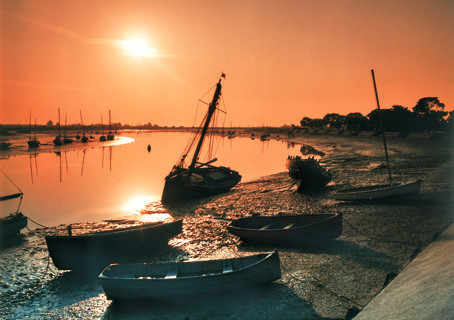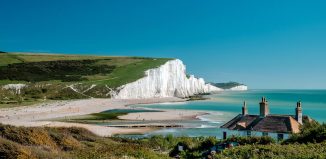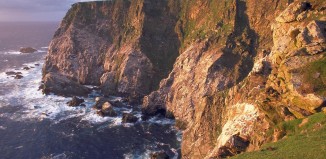Essex Discovery Coast
Paul Gogarty
For more years than I care to remember I’ve been enthusing about the beauty of the Essex coastline and its historical importance. The finely fretted creeks and marshes to the north and languorous sandy beaches further south stretch more than 350 miles, making it the second longest coastline of any English county.
There is something redolent of Arthur Ransome about its place names and rivers – Dedham, Dengie, Brightlingsea, Wivenhoe, Burnham-on-Crouch and Blackwater. It therefore comes as no surprise that Ransome set his novel Secret Water among the National Nature Reserve at Hamford Water.
An even more famous English literary figure, Daniel Defoe also opened Britain’s first travelogue, A Tour thro’ the Whole Island of Great Britain on the Essex coast. At the time the coastline was already known as London’s playground. Osea Island in the Blackwater estuary was ‘well known by our London men of pleasure, for the infinite number of wild-fowl, that is to say, duck, mallard, teal and widgeon, of which there are such vast flights, that they tell us the island, namely the creek, seems covered with them, at certain times of the year, and they go from London on purpose for the pleasure of shooting; and indeed often come home very well loaden with game.’
Today, Osea Island is privately owned (and is available for self catering breaks – www.oseaisland.co.uk), but neighbouring Northey Island is a nature reserve owned by the National Trust that is currently home to 94,000 ducks, geese and wading birds. Both islands are connected to the mainland by ancient causeways that get inundated every tide.
Horsey Island meanwhile, the setting for the Arthur Ransome novel, sits plum at the centre of Hamford Water which is best explored under the knowledgeable guidance of Tony Haggis who takes guests out on his converted fishing boat from the Naze to spot seals, birds and stud farms from March to November. An excellent eyrie for an overview of the Nature Reserve, and across to Harwich, is from the top of the Naze Tower, an 86-foot (and 111 steps) octagonal tower constructed in 1720 (less than a decade after Defoe made his trip) as a navigational mark to aid shipping and now converted into an art centre and cafe.
In Harwich Harbour you can usually spot a traditional ketch, the Clytie, very similar to the one Defoe sailed. The author claimed the harbour here to be ‘one of the best and securest in England.’ He recalls that ‘In the old Dutch War, great use has been made of this harbour; and I have known that there has been 100 sail of men of war and their attendants, and between three and four hundred sail of collier ships, all in this harbour at a time’. Defended from the Dutch by the fort and battery of guns that overlooked the only deep channel in the estuary, the harbour was strategically located at the busy end of the North Sea and, explained Defoe, ‘of a vast extent . . . safe for all weathers’ and ‘able to receive the biggest ships, and the greatest number that the world ever saw together; I mean, ships of war.’
Today the coastal town, located on the estuary of the rivers Stour and Orwell, is a busy international port but much of the old town is designated a conservation area where medieval homes stand alongside 18th and 19th century public buildings such as the parish church of St Nicholas (1821) and the Guildhall (the only Grade I-listed building in town). Among this fine collection is one of the oldest purpose-built cinemas in the UK, the Electric Palace, which celebrated its 100th birthday in 2011 and retains its ornamental frontage outside and original projection room inside.
South of Harwich, Frinton boasts a sensational long sandy beach, as well as the country’s finest collection of art deco private homes (only Morecambe can run it close). Whilst Frinton’s residents are fiercely protective of its architectural integrity and battle against any encroachment by fast food chains and pubs, nearby Clacton-on-Sea unashamedly embraces them. On its shoulder is Jaywick Martello which celebrated its 200th anniversary in Jan 2010; and just a slingshot away is St Osyth Priory, a nunnery founded for Osyth, daughter of Redwald, the first Christian king of East Anglia and of Wilburga, his wife and daughter of Penda, king of the Mercians.
Further west is Brightlingsea, a maritime heritage town and the only member of the Cinque Ports outside Kent and Sussex. A Roman fort once stood here as a crucial part of Colchester’s defences, and evidence of even earlier occupation is shown in the excavation of a major bronze age site not far from the church. At the top of Brightlingsea Creek is the village of Thorrington, with outstanding views around the only remaining Tide Mill in Essex.
Across the water from Brightlingsea is Mersea, Britain’s most easterly inhabited island and my own favourite backwater. Here, amid the beach huts, oyster beds and canted fishing boats, is the St Edmund, King and Martyr Church where you can still see parts of a moat that once enclosed five acres. It is one of the very few moated churches in the country and the site is also believed to have been the camp of the Viking Hasten who spent two winters in Mersea when plundering the country as far as Chester. The present building dates back to the12-13th century and the reign of King John. Its large, prominent tower handily provides a marker for yachts sailing the river Blackwater. The interior of the church is light, plain and airy and it was here that Sabine Baring-Gould, the island’s most famous rector, gave sermons in between writing hymns (including Onward, Christian Soldiers), penning a racy Victorian bestseller called Mehalah and fathering 14 children.
Even more famous than Sabine are Mersea Island oysters, which have been cultivated in the local creeks since Roman times and are much loved by celebrity chefs Jamie Oliver and Rick Stein (I suggest you try them at the no-frills Company Shed where you should bring your own bread and wine). Wine growing on Mersea is also thought to date back to the Romans and the Mersea Island Vineyard continues the tradition for those wishing to visit.
Maldon, located at the head of the River Blackwater, was granted a Royal Charter by Henry II in 1171 and is best known for its gourmet sea salt. But the old port is an even bigger draw for visitors. Hythe Quay played a crucial part in the prosperity of Maldon through the centuries and some of the beautifully restored Thames sailing barges moored here are available for charter or offer short trips out along the estuary. The Jolly Sailor Inn has overlooked the Quay since Tudor times.
From Maldon heading into the Dengie, we discover some of the country’s richest agricultural land, as well as its loneliest chapel. To get a real feel for its desolate beauty I strongly recommend a walk along the northernmost promontory where the misanthropic Saxon chapel of St Peter’s (or St Peter-on-the-Wall) at Bradwell looks out over mudflats, cockle spits, hovering kestrels and the occasional hen harrier. St Peter Ad Murum is reputedly the oldest complete church in England that is still in regular use and is the scene of an annual ecumenical pilgrimage on the first Saturday of July each year. Its construction by St Cedd, who sailed from Lindisfarne to preach here, marked both an end to Saxon pirateering and the first foothold of Christianity in the South. The chapel was built from the walls of the Roman fort of Othona in 654AD – an intimidating fortress at the mouth of the Blackwater that was erected to protect the estuary from the Saxon pirates. Today, the location of Othona remains a major archaeological site and part of the Dengie National Nature Reserve. The atmosphere here is like no other and the saint’s claim that “In this place the word is revealed to you” still reverberates.
A notch up the mariner’s flagpole from Maldon is Burnham-on-Crouch with three yacht clubs, one sailing club and an annual regatta that has earned it the soubriquet ‘Cowes of the East’. The town has a real feel of being at the end of things – lost amid the Dengie Marshes, it comes as no real surprise therefore that HG Wells chose it as the backdrop to a martian invasion in his War of the World’s, nor that Alfred Hitchcock, when asked about the inspiration for his films, cited a childhood visit to Burnham-on-Crouch. There are a large number of listed buildings in the town, including the rather fetching art deco Royal Corinthian Yacht Club. Humble fishermen’s weatherboard cottages hunker beneath the Georgian mansions of their former masters on the high street where there’s also an eccentric clock tower (1877) with fish scale tiled ogee roof whose lower arches the pavement has to duck under.
Across the river Crouch we come to the world’s longest pleasure pier and the endless golden sands of Southend. Less well known is a Saxon burial chamber that was uncovered recently and believed to be the richest archaeological find of the past 60 years (see side bar). Plans are now being considered to build a £30 million attraction to house it. But even before this major attraction is unveiled, the town already has a cultural parallel universe co-existing alongside its holiday attractions. Southchurch Hall is a medieval moated manor house with pretty gardens and ponds; Prittlewell Priory is even older, dating back to the 11th Century and its exhibitions tell the story of the medieval monks, those of the Victorian Scratton family who also lived there, and the park’s wildlife.
A delightful short coastal walk west leads to Leigh-on-Sea where traditional 20th century cockle sheds and traditional fishing fleet rubs shoulders with stylish art galleries. Throughout the year the town hosts folk festivals, book fairs and an annual Leigh Art Trail when artists open up their homes to visitors. Out on the mudflats in autumn, 4,500 Brent Geese wing in from their 2,500-mile trip from Siberia to graze the eel grass. Fortunately we humans can find considerably better fare in the fashionable seafront restaurants.
Prittlewell Chamber Tomb
In 2003 Southend Borough Council commissioned Museum of London Archaeology (MOLA) to undertake an archaeological evaluation of a parcel of land between the road and the railway line at Priory Crescent, Southend. The purpose was to determine the survival and extent of a mixed Roman and Saxon cemetery, parts of which had been discovered in 1923 and 1930. What the archaeologists found was, in the words of Ian Blair, a Senior Archaeologist from MOLA, a “discovery of international importance which stunningly illuminates the rich and complex world of the so-called Dark Ages”.
The 7th century burial site in Prittlewell Park quickly became known as The Tomb of the Saxon King and The Tomb of the Prittlewell Prince.
Treasures found in the chamber include a large and elaborate hanging bowl with enamelled mounts, an arrangement of gilded copper mounted wooden drinking vessels and glass vessels, a pair of shoe buckles and a sword and shield.
The nature and size of the tomb suggest that it was created for an individual of exceptional status, an impression confirmed by the wealth and quantity of the grave goods, which is second only to the finds at Sutton Hoo.
Since the discovery of the site there has been a tug of war between those determined to continue with the road expansion and those who would like a permanent museum built on the site to display the treasure, prompting a protest group to occupy the site from September 2005 to July 2009.
More information: For a host of information, including details of the towns and villages along the coast, news, videos and weather forecasts, go to the Discovery Coast section of the Visit Essex website. www.visitessex.com








